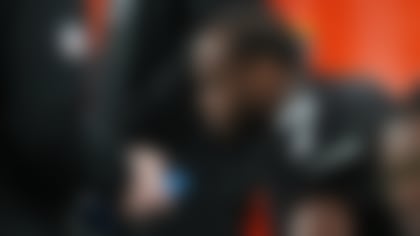Being a top-of-the-draft player, particularly if you're a quarterback, is going to lead to inspection into the person as much as the athlete, and it can be invasive. So when Cam Newton serves something up like he did to *Sports Illustrated's* Peter King earlier this week -- "I see myself not only as a football player, but an entertainer and icon." -- it's going to make waves.
Cue the red flags. Or just wave them, because guess what? Those were already there.
Billick: 'Major questions on Cam'
NFL Network's Brian Billick was asked plenty about Cam Newton during a chat Thursday and was blunt about the potential red flags surrounding the Heisman Trophy winner. **Blog...**
I mentioned this in passing in a column on Newton's potential over a month ago, but it bears re-mentioning based on his most recent comments: There's been a concern all along that, given a pro athlete's profile, the Heisman Trophy winner would take fame, run with it and "Go Hollywood."
I was told back in January there were concerns among scouts that late in Newton's time at Auburn that "Major music and film stars" were starting to circle around the quarterback.
This, by the way, wasn't to say Newton was a bad guy, because at Auburn, the exact opposite was the perception. But with so little time on The Plains, some scouts question whether things will change when some more outside forces are at work.
"Just like all you get is the bad at Florida (Newton's previous school), it's only positive at Auburn," said one personnel executive. "At Auburn, the stuff you hear is nothing but unbelieveable. He's not a prima donna, not a (jerk) to anyone. The (sports information director) likes him. The academic coordinator likes him. He doesn't walk around like a star, and I heard his work ethic is very good.
"That being said, and taking into account how smart he is, the only thing to watch for is that (element) that popped up late in the year. If he can handle it, he'll be fine."
It ties into Newton's history of "immature decisions" stemming from his time in Gainesville.
Again, there's a ton of positive on Newton, to the point where he's a very real contender to go first overall to Carolina. But let's just say that there were folks around the league who weren't surprised to hear what he said to King.
First ...
Three of the 12 players franchised through Wednesday had already signed their tenders before the period to tag had even expired. Unusual? Yes.
But these are very unusual times. And players need to be aware of their surroundings.
For Peyton Manning, Logan Mankins, Vincent Jackson, Phil Dawson, and Michael Vick, there's no need to worry about signing now. Each has six years under his belt, and thus will almost certainly reach the service-time standard for unrestricted free agency.
But the fact that LaMarr Woodley, David Harris and Ryan Kalil inked their tag tenders so quickly, and Miami's Paul Soliai is expected to do so soon, brought to light what Haloti Ngata, Tamba Hali, Marcedes Lewis, and Chad Greenway also need to think about: Fourth- and fifth-year guys won't necessarily be unrestricted, particularly in the circumstance in which the CBA expires next week, but the owners opt not to lock the players out.
While the three that have signed are in Year 3 and Soliai is in his fourth year, Ngata, Hali, Lewis and Greenway are in Year 5, making it less likely they'll be restricted. Still, if the rules roll over, and those players are tendered, they probably wouldn't make much above the max RFA tender of last year, which was $3.268 million.
In that case, Greenway and Hali would stand to lose close to $7 million, Ngata would be subject to blowing more than $9 million, and even Lewis, a tight end, could cost himself more than $4 million.
That's why the union is not standing in the way of any of the younger players signing their tags. Woodley, Kalil and Harris could each lose in the neighborhood of $7 million if their franchise tender was unsigned and their teams suddenly hit them with an RFA tender and repealed the tag.
As one source with knowledge of the union's thinking said, "This is a no-lose situation for those players, so long as the team is interested in keeping them longterm."
For Ngata, Hali, Lewis and Greenway, it's a less significant risk that they'll wind up RFAs in whatever new climate is ahead. But it's still a roll of the dice.
... and five
1. What's new is suddenly old
That the Falcons are deep in the process of building a new outdoor stadium is, indeed, a testament to the ambition of owner Arthur Blank, who has had an impressive climb off the canvas following the Vick and Bobby Petrino issues, with the help of Thomas Dimitroff and Mike Smith. But it also could be a dangerous piece of precedent-setting in the long run. The 2011 season will be the club's 20th at the Georgia Dome, which would be the first 1990s-built facility to be replaced. Put it this way: Atlanta opened the dome five months before Baltimore opened Camden Yards. Amazing. Meanwhile, the Rams have an out in their lease if the Edward Jones Dome, opened in 1995, isn't brought up to a first-class level by 2015, which would be its 21st season. St. Louis' stadium opened the same year as Jacksonville's. In 1996, Carolina opened its new digs. In 1997, the Redskins moved to Maryland. In 1998, the Ravens and Buccaneers moved into new places, and the Titans and Browns did the same in 1999. Amazing to think that, soon enough, some of those teams might be going to the table looking for new places again.
2. On the move in Houston
Was interesting to see the comments of Houston's new linebackers coach, Reggie Herring, on the Texans' official Web site. In particular, he revealed that Brian Cushing will play the strong-side inside linebacker role that Bradie James did in Dallas, with DeMeco Ryans on the weakside alongside him. Cushing has a reputation for being at his best when he's got freedom to roam and is moved to different spots, so it'll be interesting to see how new defensive coordinator Wade Phillips builds that into the defense,and into a role that requires the discipline that James was known for in Dallas. And even more interesting is how Mario Williams will be deployed. Even though he tips the scales at around 300 pounds, he's been an edge player for most of his career. The possibility could exist that he could play outside linebacker, in a DeMarcus Ware-type of role, for Houston, opposite a player like Connor Barwin, who might have been a better fit for a 3-4 all along anyway. In that scenario, Williams' playmaking ability might be highlighted a bit more, and he'd take far less of a beating than he would as 5-technique end in that type of front.
3. Cornering the market
Earlier in the week, both Ronde Barber, going into his 15th NFL season, and Champ Bailey, going into his 12th, received new contracts. This isn't apples-to-apples, since Barber got one year and Bailey got four. But it does say something about the longevity of top corners in today's game, with Charles Woodson being another example. Two years ago, Nnamdi Asomugha broke the bank with a deal that earned him $28.5 million annually in 2009 and '10, and delivered him back into free agency at 29 years old. Darrelle Revis piggy-backed a big deal off the Jets after Asomugha's contract changed the market. And the big deal Woodson, who was thought to be damaged goods at the time, got in Green Bay in 2006 now looks like a bargain. Barber and Bailey are good examples of why those investments are good ones, and the ability of such players to eventually switch positions and play safety only adds to that.
4. Bush's value to Saints
The Saints will have a decision to make on Reggie Bush in the next few weeks, with an $11.8 million base salary due in 2011 on the second pick in the 2006 draft. His career offensive numbers, through five years, have been underwhelming, given the expectations -- just 2,090 yards rushing and 294 catches for another 2,192 yards. But New Orleans coach Sean Payton has consistently said that Bush can't be judged by the numbers strictly, and last year showed it. The Saints were held to 20 or fewer points three times in a four-game stretch during Bush's absence, caused by a broken leg, which led to a 2-2 mark that cost New Orleans the NFC South title. If you talk to scouts, the big thing Bush does for the downfield-throwing Saints is force defenses to account for him as a check-down option, opening more one-on-one opportunities deep for New Orleans' group of big receivers. Soon enough, we'll know how much value the Saints put on that.
5. Indy 40
Speaking of tailbacks, two to watch at the combine are Oklahoma State's Kendall Hunter and Oregon State's Jacquizz Rodgers. If each finds a way to burn up the 40, chances are he could rise like Chris Johnson did in 2008 after the Titans' dynamo raced to a 4.24 in Indy. Like Johnson, Hunter and Rodgers are smaller than the prototype, but Johnson's 2,000-yard season has helped change some perception of what a lead back needs to be. During the college season, I asked a GM about who might benefit from Johnson's success. And the names of Hunter and Rodgers were the ones he raised. So keep an eye on them when you're tuning into our coverage this week.
Follow Albert Breer on Twitter @AlbertBreer



